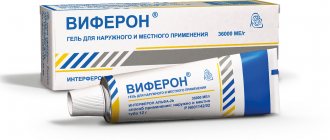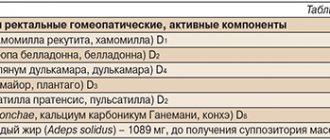Buy Ibuprofen-Altpharm rectal suppositories 60 mg No. 10 in pharmacies
Instructions for use Ibuprofen Buy Ibuprofen supp. rect. 60 mg No. 10 Dosage forms suppositories 60 mg, suppositories 60 mg Manufacturers Rofarma (Russia) Group Anti-inflammatory drugs - propionic acid derivatives Composition Active substance: Ibuprofen. International nonproprietary name Ibuprofen Indications for use:
For rectal use (children from 3 months to 2 years): as an antipyretic - acute respiratory infections, acute respiratory viral infections, influenza, other infectious and inflammatory diseases accompanied by an increase in body temperature; post-vaccination reactions. As an analgesic - pain of mild or moderate intensity (including headache and toothache, migraine, neuralgia, pain in the ears and throat, pain with sprains). ** Contraindications:
Hypersensitivity. For oral use: erosive and ulcerative diseases of the gastrointestinal tract in the acute phase (including peptic ulcer of the stomach and duodenum, Crohn's disease, ulcerative colitis, peptic ulcer), "aspirin" bronchial asthma, urticaria, rhinitis, provoked by taking salicylates or other NSAIDs; bleeding disorders (including hemophilia, hypocoagulation, hemorrhagic diathesis), optic nerve diseases, scotoma, amblyopia, color vision impairment, asthma, leukopenia, thrombocytopenia, hemorrhagic diathesis, confirmed hyperkalemia, severe liver failure or active liver disease, severe renal failure (creatinine clearance <30 ml/min), progressive kidney disease, severe heart failure, children up to 12 years of age (tablets, capsules, granules for solution), up to 6 years (effervescent tablets), up to 3 months (suspension for administration orally for children, rectal suppositories for children). For IV use: life-threatening infection, clinically significant bleeding (especially intracranial or gastrointestinal), thrombocytopenia or coagulation disorder, significant renal impairment, congenital heart disease in which a patent ductus arteriosus is a prerequisite for satisfactory pulmonary or systemic blood flow (eg pulmonary atresia, severe tetralogy of Fallot, severe coarctation of the aorta); diagnosed or suspected necrotizing enterocolitis. For external use: weeping dermatoses, eczema, violation of the integrity of the skin (including infected abrasions and wounds).
Rectal suppositories Ibuprofen for children
With simultaneous use, ibuprofen reduces the effect of antihypertensive drugs (ACE inhibitors, beta-blockers), diuretics (furosemide, hydrochlorothiazide).
When used simultaneously with anticoagulants, their effect may be enhanced.
When used simultaneously with GCS, the risk of side effects from the gastrointestinal tract increases.
When used simultaneously, ibuprofen can displace indirect anticoagulants (acenocoumarol), hydantoin derivatives (phenytoin), and oral hypoglycemic drugs, sulfonylurea derivatives, from compounds with blood plasma proteins.
When used simultaneously with amlodipine, a slight decrease in the antihypertensive effect of amlodipine is possible; with acetylsalicylic acid - the concentration of ibuprofen in the blood plasma decreases; with baclofen - a case of increased toxic effects of baclofen has been described.
When used simultaneously with warfarin, an increase in bleeding time is possible; microhematuria and hematomas were also observed; with captopril - the antihypertensive effect of captopril may be reduced; with cholestyramine - a moderate decrease in the absorption of ibuprofen.
When used simultaneously with lithium carbonate, the concentration of lithium in the blood plasma increases.
When used simultaneously with magnesium hydroxide, the initial absorption of ibuprofen increases; with methotrexate - the toxicity of methotrexate increases.
The simultaneous use of NSAIDs and cardiac glycosides can lead to worsening heart failure, a decrease in glomerular filtration rate and an increase in the concentration of cardiac glycosides in the blood plasma.
There is evidence of the likelihood of an increase in the concentration of methotrexate in the blood plasma during the use of NSAIDs.
With simultaneous use of NSAIDs and cyclosporine, the risk of nephrotoxicity increases.
NSAIDs may reduce the effectiveness of mifepristone, so taking NSAIDs should be started no earlier than 8-12 days after stopping mifepristone.
Concomitant use of NSAIDs and tacrolimus may increase the risk of nephrotoxicity.
Concomitant use of NSAIDs and zidovudine may lead to increased hematotoxicity. There is evidence of an increased risk of hemarthrosis and hematomas in HIV-positive patients with hemophilia who received concomitant treatment with zidovudine and ibuprofen.
In patients receiving concomitant treatment with NSAIDs and quinolone antibiotics, the risk of seizures may increase.
In patients receiving concomitant NSAIDs and myelotoxic drugs, hematotoxicity increases.
With the simultaneous use of ibuprofen and cefamandole, cefoperazone, cefotetan, valproic acid, plicamycin, the incidence of hypoprothrombinemia increases.
With the simultaneous use of ibuprofen and drugs that block tubular secretion, there is a decrease in excretion and an increase in plasma concentration of ibuprofen.
With the simultaneous use of ibuprofen and inducers of microsomal oxidation (phenytoin, ethanol, barbiturates, rifampicin, phenylbutazone, tricyclic antidepressants), there is an increase in the production of hydroxylated active metabolites and an increased risk of developing severe intoxications.
Ibuprofen
The simultaneous use of ibuprofen with the following drugs should be avoided:
- acetylsalicylic acid: with the exception of low doses of acetylsalicylic acid (no more than 75 mg per day) prescribed by a doctor, since combined use may increase the risk of side effects. With simultaneous use, ibuprofen reduces the anti-inflammatory and antiplatelet effect of acetylsalicylic acid (an increase in the incidence of acute coronary insufficiency in patients receiving small doses of acetylsalicylic acid as an antiplatelet agent is possible after starting ibuprofen);
- other NSAIDs, in particular selective COX-2 inhibitors: simultaneous use of two or more drugs from the NSAID group should be avoided due to a possible increased risk of side effects;
Use with caution simultaneously with the following medications:
- anticoagulants and thrombolytic drugs: NSAIDs can enhance the effect of anticoagulants, in particular warfarin and thrombolytic drugs;
- antihypertensive drugs (ACE inhibitors and angiotensin II antagonists) and diuretics: NSAIDs may reduce the effectiveness of drugs in these groups. In some patients with impaired renal function (eg, dehydrated patients or elderly patients with impaired renal function), coadministration of ACE inhibitors or angiotensin II antagonists and cyclooxygenase inhibitors may lead to a deterioration of renal function, including the development of acute renal failure. (usually reversible). These interactions should be considered in patients taking coxibs concomitantly with ACE inhibitors or angiotensin II antagonists. In this regard, the combined use of the above drugs should be prescribed with caution, especially in the elderly. Patients should be prevented from dehydration and consideration should be given to monitoring renal function upon initiation of this combination treatment and periodically thereafter. Diuretics and ACE inhibitors may increase the nephrotoxicity of NSAIDs;
- glucocorticosteroids: increased risk of gastrointestinal ulcers and gastrointestinal bleeding;
- antiplatelet agents and selective serotonin reuptake inhibitors: increased risk of gastrointestinal bleeding.
- cardiac glycosides: simultaneous administration of NSAIDs and cardiac glycosides can lead to worsening heart failure, a decrease in glomerular filtration rate and an increase in the concentration of cardiac glycosides in the blood plasma;
- lithium preparations: there is evidence of the likelihood of an increase in the concentration of lithium in the blood plasma during the use of NSAIDs;
- methotrexate: there is evidence of the likelihood of an increase in the concentration of methotrexate in the blood plasma during the use of NSAIDs;
- cyclosporine: increased risk of nephrotoxicity with simultaneous administration of NSAIDs and cyclosporine;
- mifepristone: NSAIDs should be started no earlier than 8-12 days after taking mifepristone, since NSAIDs may reduce the effectiveness of mifepristone;
- tacrolimus: with simultaneous administration of NSAIDs and tacrolimus, the risk of nephrotoxicity may increase;
- zidovudine: simultaneous use of NSAIDs and zidovudine may lead to increased hematotoxicity. There is evidence of an increased risk of hemarthrosis and hematomas in HIV-positive patients with hemophilia who received concomitant treatment with zidovudine and ibuprofen;
- quinolone antibiotics: in patients receiving concomitant treatment with NSAIDs and quinolone antibiotics, the risk of seizures may increase;
— myelotoxic drugs: increased hematotoxicity;
- cefamandole, cefoperazone, cefotetan, valproic acid, plicamycin: increased incidence of hypoprothrombinemia;
- drugs that block tubular secretion: decreased excretion and increased plasma concentration of ibuprofen;
- inducers of microsomal oxidation (phenytoin, ethanol, barbiturates, rifampicin, phenylbutazone, tricyclic antidepressants): increased production of hydroxylated active metabolites, increased risk of developing severe intoxications;
— microsomal oxidation inhibitors: reducing the risk of hepatotoxicity;
- oral hypoglycemic drugs and insulin, sulfonylurea derivatives: enhanced effect of drugs;
- antacids and cholestyramine: decreased absorption;
- uricosuric drugs: decreased effectiveness of drugs;
- caffeine: increased analgesic effect.
Nurofen for children Suppositories, 10 pcs, 60 mg, rectal, for children
Side effect
The risk of side effects can be minimized if the drug is used for a short time, at the minimum effective dose required to eliminate symptoms. Side effects are predominantly dose-dependent. The following adverse reactions were observed with short-term use of ibuprofen in doses not exceeding 1200 mg daily. When treating chronic conditions and with long-term use, other adverse reactions may occur. The incidence of adverse reactions was assessed based on the following criteria: very often (≥110), often (from ≥1100 to less than 110), infrequently (from ≥11000 to less than 1100), rarely (from ≥110,000 to less than 11000), very rarely (less than 110 000), frequency unknown (no frequency estimates available). From the hematopoietic system: very rarely - hematopoietic disorders (anemia, leukopenia, aplastic anemia, hemolytic anemia, thrombocytopenia, pancytopenia, agranulocytosis). The first symptoms of such disorders are fever, sore throat, superficial oral ulcers, flu-like symptoms, severe weakness, nosebleeds and subcutaneous hemorrhages, bleeding and bruising of unknown etiology. From the immune system: infrequently - hypersensitivity reactions (nonspecific allergic reactions and anaphylactic reactions), reactions from the respiratory tract (bronchial asthma, including its exacerbation, bronchospasm, shortness of breath, dyspnea), skin reactions (itching, urticaria, purpura , Quincke's edema, exfoliative and bullous dermatoses, including toxic epidermal necrolysis, Stevens-Johnson syndrome, erythema multiforme), allergic rhinitis, eosinophilia. very rarely - severe hypersensitivity reactions, including swelling of the face, tongue and larynx, shortness of breath, tachycardia, arterial hypotension (anaphylaxis, Quincke's edema or severe anaphylactic shock). From the gastrointestinal tract: infrequently - abdominal pain, nausea, dyspepsia. rarely - diarrhea, flatulence, constipation, vomiting. very rarely - peptic ulcer, perforation or gastrointestinal bleeding, melena, hematemesis, ulcerative stomatitis, gastritis. frequency unknown - exacerbation of ulcerative colitis and Crohn's disease. From the hepatobiliary system: very rarely - liver dysfunction, hepatitis. From the urinary system: very rarely - acute renal failure, especially with long-term use, in combination with an increase in the level of urea in the blood plasma and the appearance of edema, papillary necrosis. From the nervous system: infrequently - headache. very rarely - aseptic meningitis (in patients with autoimmune diseases). From the cardiovascular system: frequency unknown - heart failure, peripheral edema, with long-term use there is an increased risk of thrombotic complications (for example, myocardial infarction, stroke), increased blood pressure. From the respiratory system: frequency unknown - bronchial asthma, bronchospasm, shortness of breath. Other: very rarely - edema, including peripheral edema. Laboratory values: hematocrit or hemoglobin may decrease. bleeding time may increase. The concentration of glucose in the blood plasma may decrease. CC may decrease. plasma creatinine concentration may increase. hepatic transaminase activity may increase. If side effects occur, the patient should stop taking the drug and consult a doctor.



